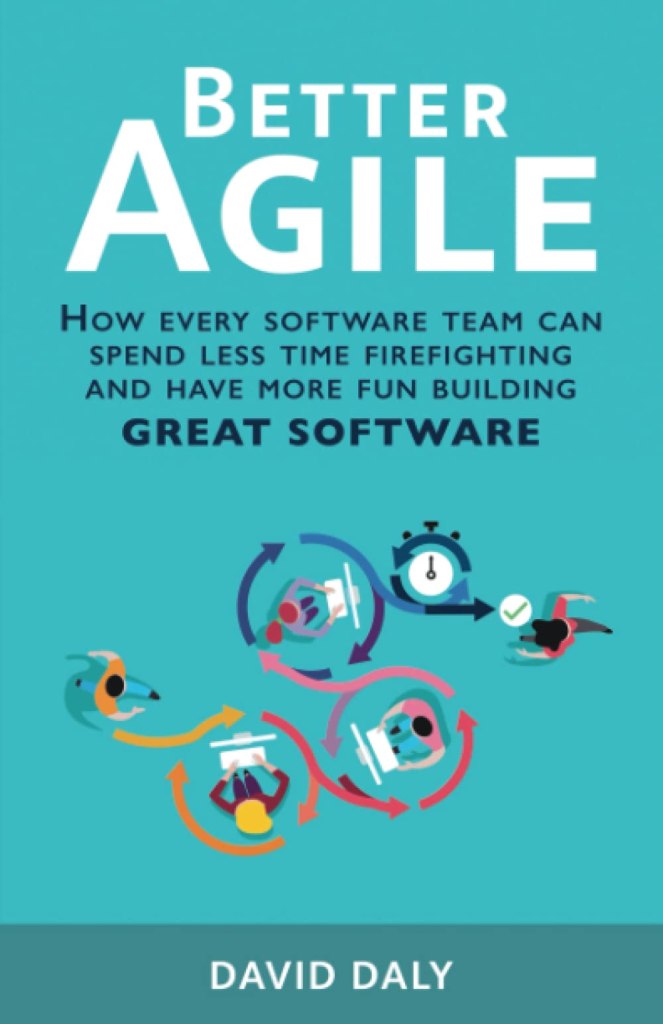
The book Better Agile – How every software firm can spend less time firefighting and have more fun building great software by David Daly highlights his experiences to make agile work. It offers Scrum and Kanban mistakes to avoid and three agile secrets to continuously improve your agility.
The book can be divided in two parts. The first part elaborates on the author’s three agile secrets: how to optimize for flow, how to get the right people doing the right things and the impact of the right feedback loops on the product as well as the team effectiveness. The second part gives 10-minute overviews and mistakes to avoid of Scrum and Kanban and how to choose between Scrum and Kanban. Maybe it was better to reverse the order and start with second part because that would be more in line how organizations will start with their agile journey.
Secret #1: Optimize for flow
In case people are overloaded, are multitasking to extreme levels, are too busy, have changes blocked, are spending more time on fixing then implementing new features, you must optimize for flow. To increase flow efficiency (is touch time divided by lead time) can be done by:
- Reduce batch sizes: reduces overall lead time (or elapsed time is touch time + wait time), especially when large batches occur before a continuous process
- Reduce overall lead time
- Use the ToC to identify and alleviate bottlenecks by increasing focus, support and/or capacity
- Understand common sources of blockers on your team and find ways to reduce the delay they cause
- Shorten feedback cycles to reduce the effort spent on rework.
To support this secret and the other secrets several coaching questions are mentioned as well as further reading.
Secret #2: Get the right people doing the right things
When people are not focused on the most important work or frustrated with always working on the same kind of task or technology or when there are not enough people with the right skills or there is a lack of knowledge sharing between team members you benefit from getting the right people doing the right things.
It will help when you:
- Capture all requests for work in a single backlog (yes, but I would say a single ‘short’ backlog. Saying ‘no’ in a substantiated way is a key competence too).
- Do just enough prioritisation of your backlog so the team knows what is most important to work on next
- Make sure how work is added to the backlog and how it is prioritised is transparent and visible to all stakeholders
- Use guided self-selection to allocate work
- Allocate work to avoid key-person dependencies: the most experienced people on the team should spend much of their time coaching and supporting others.
Secret #3: Shorten feedback loops
Are mistakes made more than once, do changes not always deliver the intended benefits, does it take too long to diagnose and fix problems, it will help to shorten feedback loops.
- Feedback about the product:
- Software builds
- Software testing (is it bug free)
- Customers
- End-users
- Feedback about how effectively the team is working:
- Analysis of key metrics (elapsed lead time, frequency of deployments, change failure rate, time to restore after failure)
- Regular opportunities to reflect on their performance and proposed improvements
- Information radiators (walls, whiteboards, screens, bells, et cetera).

Scrum mistakes to avoid
After a 10-minute overview of Scrum, the following 5 mistakes are explained:
- Water-Scrum-Fall
- Multi-sprint stories
- Ineffective Product owner
- Not reaching a potentially shippable state in every sprint
- Ignoring required technical practices
Kanban mistakes to avoid
After a 10-minute overview of Kanban including a short explanation of Scrumban (using Kanban to support your Scrum way of working), the following 5 mistakes are explained:
- Task-board only
- Not limiting WIP
- Not starting with what you do now
- No feedback loops
- Mapping who does the work rather than the value-adding steps
Scrum, Kanban or?
The chapter How to choose between Scrum and Kanban is according to the author very short and rather obvious. Too short in my opinion if you want to use this to choose between frameworks like SAFe, LeSS or others.
The book ends with a 5-minute agility self-assessment to understand where to start to become more agile and a recap of the coaching questions to support the three agile secrets.
Conclusion.
Better Agile is a practical, easy to understand guide to continuously improve your agility. It gives insights in some common mistakes in Scrum and Kanban. It shows how to optimize for flow, how to get the right people doing the right things and the impact of the right feedback loops on the product as well as the team effectiveness. The 55 coaching questions and the 5-minute agility self-assessment are helpful. What I miss is a fourth secret regarding the agile mindset and culture. The organization’s culture is often at odds with the agile culture and that’s a key reason why agility isn’t improving. Finally, I have my doubts if, after reading this book, you have the skills to make an informed choice about any method, including frameworks for scaling agile. See e.g., my articles The evolution of agile frameworks and The bird’s eye view on the agile forest.
To order Better Agile: Amazon.com
















Pingback: Overview of my year 2022 book reviews | Henny Portman's Blog